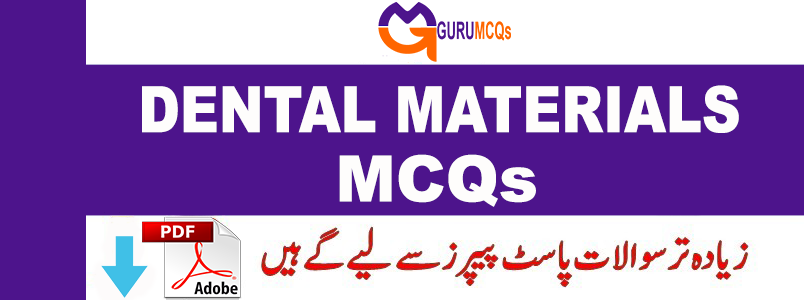
Dental impression materials, also known as dental materials, initially exist in a liquid or semi-solid state upon mixing and placement in the mouth. Over a few minutes, these materials undergo a setting process, transforming into an elastic solid. During this time, they capture an accurate imprint of an individual’s dentition and the surrounding structures within the oral cavity. GuruMCQs.com provides all updated Dental Materials MCQs. MCQs of dental materials content are updated regularly, with the addition of new topics, more questions, and useful links. Repeated dental materials MCQs consist of impression materials like Amalgams, Dental Cements, Direct Filling Gold, Gypsum Products MCQs, Impression Materials, Metallurgy, Physical Properties, Dental Ceramics & Miscellaneous, Restorative Resins – and much more. These multiple-choice questions (MCQs) in dental materials serve as valuable resources for various purposes such as interview preparation, entrance exams, competitive assessments, and certifications for individuals at all levels of experience, including experienced professionals, newcomers, and students. Additionally, you can find MCQs on oral histology for further exploration.
91. The setting time of irreversible hydrocolloids can be decreased by_____________?
A. Raising the temperature of water used for maxing
B. Using excess water for maxing
C. Lowering the temperature of water used for mixing
D. None of the above
92. Rubber base impressions are poured immediately as they_______________?
A. Continue to polymerize
B. Become elastic
C. Show imbibition and syneresis
D. Show gelation
93. The most mucostatic impression material is_______________?
A. Thin mix of plaster of paris
B. Zinc oxide eugenol impression paste
C. Free flowing wax
D. Reversible hydrocolloids
94. The best way to remove a hydrocolloid impression from the patient’s mouth is____________?
A. Slight rocking of the impression to disengage it from the undercut
B. Wetting the periphery of the impression with moist cotton to break the peripheral seal
C. Sudden jerking of the impression to prevent tearing
D. Supporting the impression along with the tray to prevent disengaging of the tray alone
95. Palatal secretions affect the setting of all the impression materials except_______________?
A. Silicone
B. Agar-agar
C. Impression paste
D. Impression plaster
96. Lenolin is added is ZOE paste to______________?
A. Decrease flow
B. Increase flow
C. Accelerate reaction
D. Decrease irritation due to eugenol
97. Agar is prepared from_______________________?
A. Bullock heart
B. Chemicals
C. Sea weed
D. Chick cells
98. Perforated impression tray are used for_______________?
A. Alginate
B. Zinc oxide-eugenol
C. Agar-agar
D. Impression compound
99. During setting of alginate impression materials________________?
A. Trisodium phosphate reacts with sodium alginate
B. Trisodium phosphate reacts with calcium sulphate
C. Colloidal changes to sol
D. Material in contact with soft tissues sets last
100. K2SO4 in agar-agar is for_______________?
A. Accelerating the setting stage of gypsum
B. Increase strength
C. Give dimensional stability
D. None of the above
